Table of contents
- Sitting position and levering Sit properly, drive easily
- Adjust levers and pedals
- Padding
- Deep seat + chassis conversion
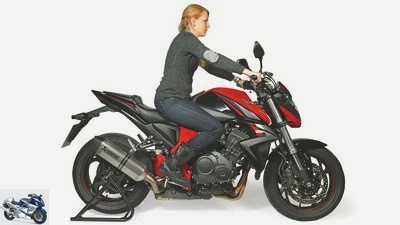
Yvonne Hertler
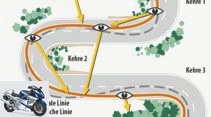
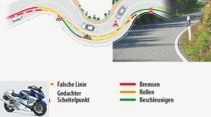
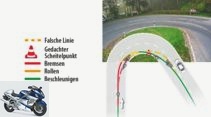
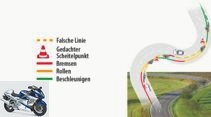
26th pictures
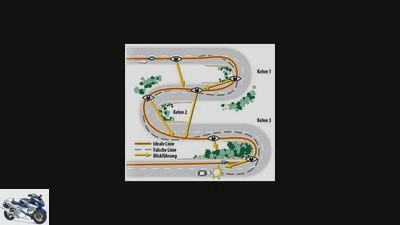
MOTORCYCLE
1/26
On the way on alpine passes? That’s how it works!
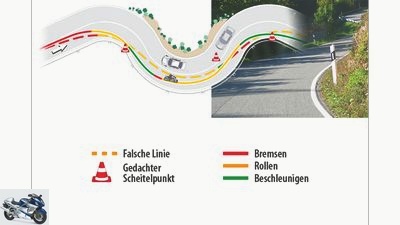
MOTORCYCLE
2/26
Seductive winding curves with risk. The course of the road cannot be seen for the most part, which is why a car or motorcycle can appear unexpectedly – uncomfortable to dangerous when you cut the curves. The so-called undercutting of the curves is therefore better, especially since you always have to expect that a driver in oncoming traffic will cut the S-curve and, in the worst case, come along on the wrong side of the road. If we have then cut the curve ourselves, our chances are extremely slim.
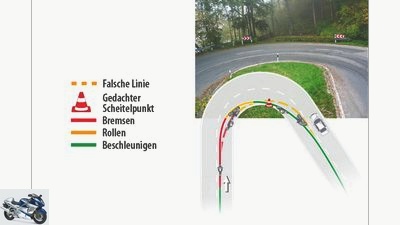
MOTORCYCLE
3/26
The classic curve, which allows a finely arranged ideal line and corresponding leanings due to its clarity. However, if you cut the curve (dashed line), the motorcycle must drive the greatest lean angle at the exit of the curve, if you do not want to go on a collision course with possible oncoming traffic. In the case of undercutting (solid line), on the other hand, the apex is later (pylons). You can see better around the bend, which is why you can accelerate much earlier on the flatter line, which more than makes up for the slightly slower cornering speed.
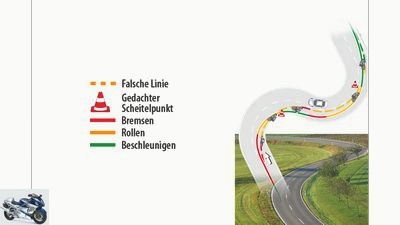
MOTORCYCLE
4/26
In alternating curves, the advantage of undercutting comes into play even more, because the apex, which is set late in the right-hand bend, allows the following left-hand bend to be approached from far outside. The driver on the wrong line (dashed) is pushed in the direction of the opposite lane, and he has to turn hard from an extremely unfavorable position for the following left-hand bend. A liquid, round line cannot be made with it.
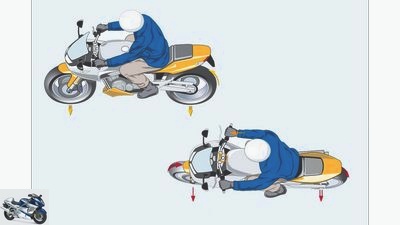
MOTORCYCLE
5/26
The three phases of cornering.
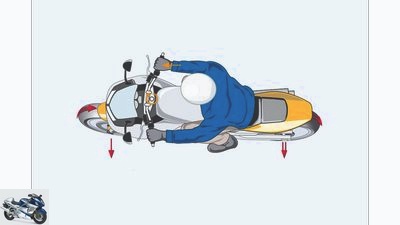
MOTORCYCLE
6/26
Red phase: Adaptive braking before turning. Turning in on the brakes is critical, because many machines, especially those with wide tires, cause an erection torque.
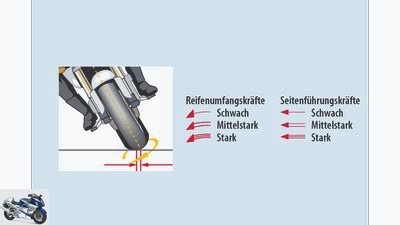
MOTORCYCLE
7/26
The contact area of the front tire moves out of the wheel center plane (see yellow dashed line) and the motorcycle tries to straighten up. The driver has to compensate for this phenomenon by counter-steering. In our driving tests, a necessary counter-steering force of up to 250 Newton meters was found at a twelve degree incline.
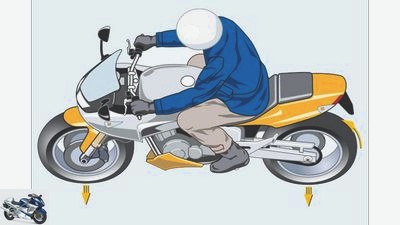
MOTORCYCLE
8/26
Yellow phase: Lean during the roll phase. In this driving state, the circumferential forces on the front wheel are very low, while the driving force acts on the rear wheel depending on the constant speed – at 100 km / h around eight hp. The tires can now transfer high lateral forces and thus cope with an enormous lean angle. If the lean angle is too great, the tires lose their grip, usually the narrower front tire first. Conversely, too low cornering speed can lead to overturning; Early easy acceleration helps.
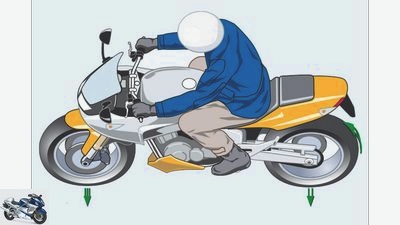
MOTORCYCLE
9/26
Green phase: Accelerate from a lean angle. At the exit of the curve, the gas is gently drawn up, causing the motorcycle to stand up and the curve radius increases. If you want to push the straightening up, additional pressure at the end of the handlebars on the outside of the curve helps. Depending on the acceleration, a more or less strong circumferential force acts on the rear tire. This is why it can withstand less lateral forces and therefore lean angles than the front tire, which guarantees safe lateral guidance in an inclined position.
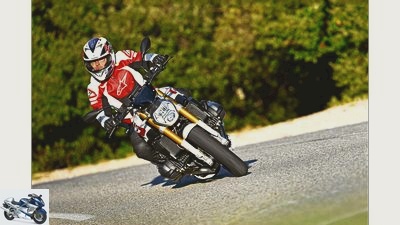
Gargolov
10/26
The classic – lean into the curve: the driver and machine form a line when tilted. Either with a firm knee or a relaxed, sporty knee, this driving style is suitable for all types of curves at any speed. The direction of travel can be corrected very quickly, from laying down you can seamlessly switch to pushing in alternating curves. The relaxed posture does not require much strength. Good to see here: The driver bends his head to keep his horizon as straight as possible, his gaze is directed towards the exit of the curve.
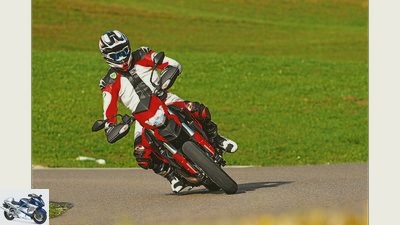
Bilski
11/26
Push: This curve technique originally comes from off-road sports. The driver remains relatively upright, the motorcycle is pushed down with the handlebars. Hip bend and firm knee closure help. This works well in tight bends and serpentines, with quick changes of course or evasive maneuvers. Ideal for gravel roads and on loose or slippery surfaces because the body’s center of gravity is above the tire contact area.
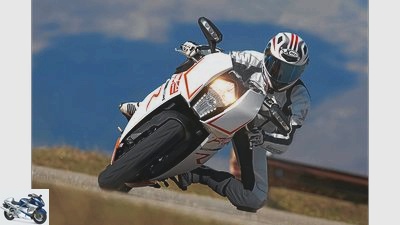
jkuenstle.de
12/26
Hanging-off: This driving style is tailored to the seating position and chassis geometry of super athletes and is mainly used on the racetrack, where the further course of the route is known. With the same cornering speed, it requires less lean angle, but strength and a lot of practice. The photos show that, regardless of the cornering style, a motorcycle needs considerably more space than when driving straight ahead, which is why you should never get too close to the center of the lane when cornering to the left. And to the right, the delineator posts lurk for (athlete) mirrors rushing past too closely.
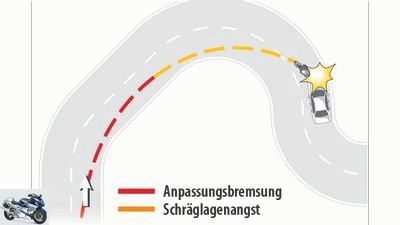
MOTORCYCLE
13/26
You should avoid this mistake.
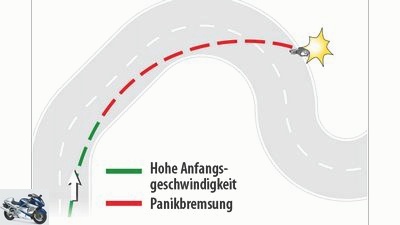
MOTORCYCLE
14/26
This mistake should also be avoided: Too high an initial speed and panic braking.
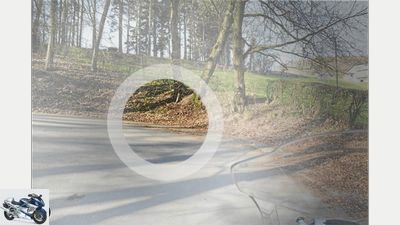
Streblow
15/26
Correct viewing is often difficult uphill. The dirt on the right-hand side of the lane also first demands attention and thus draws attention to itself.
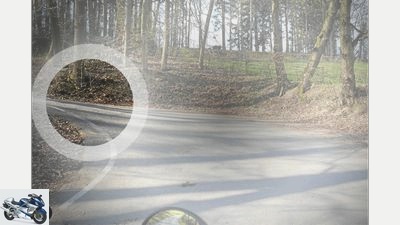
Streblow
16/26
Now it’s time to “keep your head up” and look uphill to see if there is oncoming traffic and how the road will continue. We don’t see yet what the next picture shows.
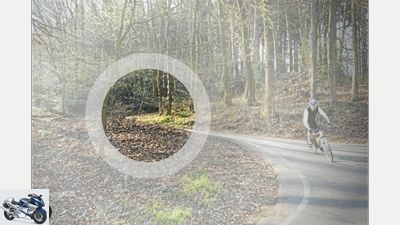
Streblow
17/26
Looking ahead at an early stage prevents us from being frightened by the now emerging cyclist and allows us to perceive the following right-hand bend in good time.
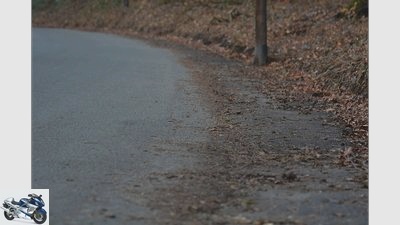
Streblow
18/26
In left-hand bends, the lane can get really narrow. Because if we drove too far to the left we would come into oncoming traffic, and on the right edge of the road there were leaves, gravel and other rubbish. You should stay away from this as much as possible in an inclined position.
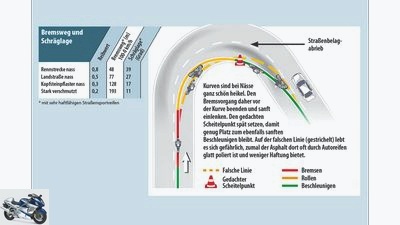
MOTORCYCLE
19/26
The measured values of a Honda CBR 600 F show how different road surfaces in the rain affect the braking distance and the possible lean angle. The braking distance is hardly longer on grippy racetrack asphalt than on dry slopes. On the wet country road, however, the sports touring bike needs 77 meters to brake hard from 100 km / h, and significantly more if the surface is poor. In addition, the possible inclination is drastically reduced.
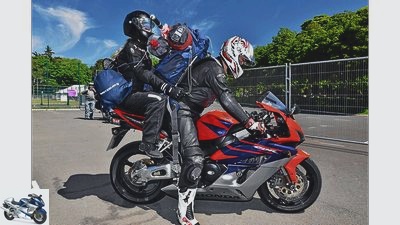
MOTORCYCLE
20/26
Topic loading:
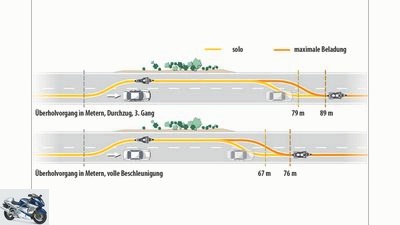
MOTORCYCLE
21/26
A fully loaded motorcycle is slower and less powerful than a machine on which only the driver is sitting. Actually clear, but in the heat of the curve fight on the country road you sometimes forget that, especially when the tour for two and with luggage is more the exception than the rule. The two examples above use a Suzuki GSX 1250 FA to show that overtaking with a load takes significantly longer. The Suzi has at least 98 hp and remains relatively powerful; with weak engines, the path can even double.
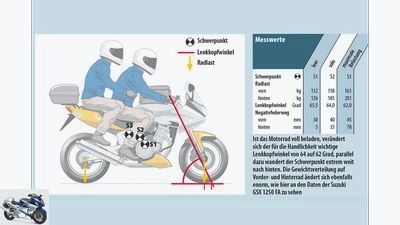
MOTORCYCLE
22/26
Important: The chassis must be adjusted when loading.
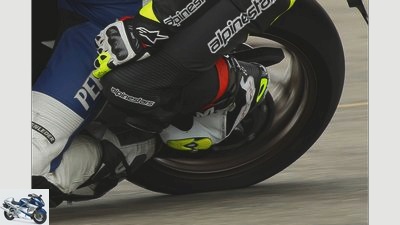
Bilski
23/26
Leaning under a load is hard work for the rear tire. If there is still too little air in it, the rear of the machine can really rock up.
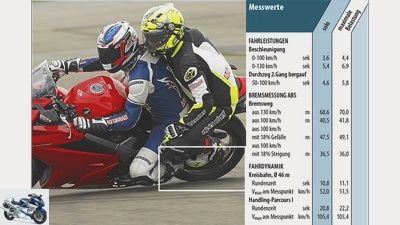
Bilski
24/26
When loaded, the performance and braking behavior of a motorcycle change. Since there is significantly more weight on the rear wheel than normal, the front wheel becomes light when you accelerate and lifts off noticeably earlier. Depending on the tires, handlebar flutter (shimmy) can increase between 60 and 100 km / h. Therefore: Do not drive hands-free or with only one hand on the handlebars when the vehicle is loaded. Anyone traveling in the Alps should take into account that the braking distance increases on steep inclines, as shown by braking measurements with a Honda VFR 800. The other measurement data show that the acceleration and, above all, the pulling power of the almost five hundred pound heavy sports tourer deteriorate significantly – take into account when overtaking!
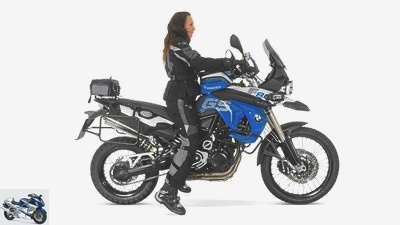
manufacturer
25/26
Sitting position: If, as here, only the tips of your toes reach the floor, it is not enough to just reduce the spring base on the fork and shock absorber. Because not only is the progress too little, such a suspension setting also leads to unsatisfactory driving characteristics.
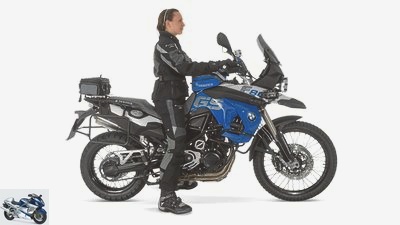
manufacturer
26/26
The lowering kit and the extra-deep seat bring real progress. In the case of the BMW F 800 GS, other fork springs that match the shortened rear shock are installed at the front. All in all, the seat height is reduced by around 70 millimeters.
counselor
Driving experience & Driving tips
Ergonomics and correct sitting
Sitting position and levering
Sit properly, drive easily
Motorcycles ride well and safely
Lounging casually like on a cruiser, loosely upright like on the naked bike in the picture above or crouched sportily with stub handlebars and high footrests – how we sit on a motorcycle depends to a large extent on how the seat, footrests and handlebars are arranged in relation to one another.
Nicolas Streblow
04/02/2019
Important in all cases: The ergonomics match our body dimensions and the seating position gives a good feeling of security, overview and vehicle control. The back straight as in the picture above, but not straight into the hollow back, the arms slightly bent, the view far ahead, that can be regarded as the basic position. When we have to stretch our arms, the handlebars are too far away and we have to make the decision whether to bring them closer or to lean forward. Except for the levers, the handlebar position in the brackets and, on some machines, the seat height, nothing can usually be adjusted, so adjustments to personal ergonomics often require conversion.
It can be worthwhile, because we don’t want to sit cramped on the bike, but ideally take an active sitting position with our pelvis slightly tilted forward and our legs and upper body slightly tense. Only then can we quickly shift our body weight as required by the situation: when accelerating, we support ourselves with our legs, when braking we use our knees to support ourselves forward on the tank. In curves we slide inward slightly or follow the change in lean angle of the motorcycle with a hip bend. In this way, the handlebars are not misused as a handrail, so that we do not introduce any interference into the chassis.
Adjust levers and pedals
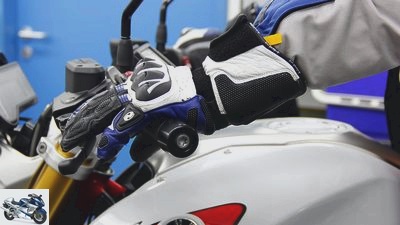
mps studio
With the hand extended to the brake and clutch levers, the driver’s forearm, palm and fingers should form a straight line.
The sitting posture significantly influences the mobility of shoulders, neck and head and thus the immensely important visual guidance. Anyone who drives a sports motorcycle with low handlebar stubs will notice it quickly – at the latest when they turn into the first uphill serpentine. Or if you try to keep your back halfway straight on a long cruiser with forward footrests.
Finally, your hands should always hold the grips loosely, because if you cling to the handlebars with your arms stretched out, you inevitably cramp up and cannot develop a fluid driving style. What that means for riders of sports motorcycles is that they have to hold their upper body with their back muscles so that the whole weight is not on their hands.
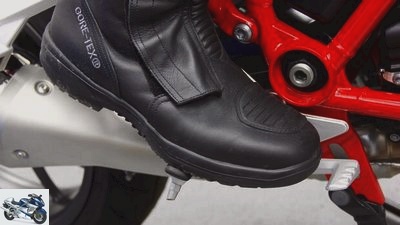
Hertler
Adjust the foot brake lever to your own needs.
Finally, two tips: what can be adjusted on levers and pedals should be adapted to the active sitting position. And if on longer tours the body tension does decrease and you notice how you slump in the saddle, maybe your shoulders even cramp, the neck becomes stiff and the riding fun disappears: sit up straight, shoulders and arms relaxed, looking ahead, alternating hands firmly and loosely around the handles, feet with the balls of the feet on the notches. And take a break at the next opportunity.
Padding
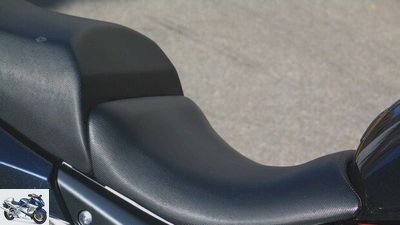
Cook
The thinner the upholstery that is left over after padding, the better its quality must be.
If you don’t want to sacrifice all seating comfort when upholstering a motorcycle seat, it is better to leave it to a specialist company. Simply cutting out material from the original seat cushion is not enough. Usually, it is not just a new, tailor-made cover that is necessary. Special composite foams with their higher density improve the chance that the bench will not become a torture bench despite the loss of material.
A bench that is adapted to the individual weight guarantees good seating comfort despite the reduced support. This is especially true if the bench is not only padded, but also made narrower at the same time. Depending on the shape, you gain the decisive centimeters up to the ground contact, but you have to be careful not to come into conflict with the frame tubes.
Deep seat + chassis conversion
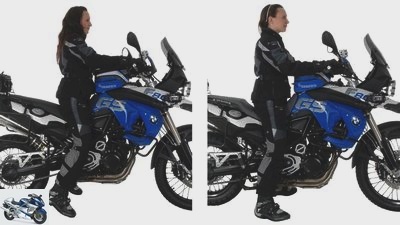
manufacturer
BMW F 800 GS with and without lowering kit
If, as here, only the tips of the toes reach the ground, it is not enough to reduce the spring base on the fork and shock absorber. On the one hand, the effect is too small, on the other hand, such a chassis (incorrect) setting also leads to unsatisfactory driving characteristics.
A lowering kit and an extra deep seat bring real progress. In the case of the BMW F 800 GS, the shock absorber is shortened; Matching fork springs are used at the front. All in all, the seat height is reduced by around 70 millimeters
Related articles
-
Correct cornering with the motorcycle
Jahn 28 pictures Kawasaki 1/28 Curves are the icing on the cake for motorcyclists. Without them, life on two wheels would be bland. Muller 2/28 3. Green…
-
Bagar / www.varahannes.at Sports & scene Correct curve line Visibility, momentum and security The optimal curve line If the basic skills of cornering,…
-
PS reader question about ergonomics on the motorcycle
jkuenstle.de Sports & scene Motorsport PS reader question about ergonomics on the motorcycle PS reader question about ergonomics on the motorcycle Sits,…
-
Tips for mechanics – correct motorcycle chain maintenance
Photo: Ralf Petersen 13th pictures Ralf Petersen 1/13 / 1 / A typical lack of maintenance: everything sparkling clean, even the chain. Ralf Petersen 2/13…
-
MV Vario handlebars and rests: ergonomics change at the push of a button
Thomas Schmieder 9 pictures Thomas Schmieder 1/9 Gunter Verhaben has developed electrically adjustable handlebars and footrests with his company MV…
-
MSC cornering ABS in the test in the KTM 1190 Adventure
Jahn motorcycles MSC cornering ABS in the test in the KTM 1190 Adventure MSC in the KTM 1190 Adventure put to the test ABS suitable for lean angles…
-
Driving tips and advice on motorcycling
fact 26th pictures MOTORCYCLE 1/26 On the way on alpine passes? That’s how it works! MOTORCYCLE 2/26 Seductive winding curves with risk. The course of…
-
Valentin Brandes, Stephan Floss Fotorgrafie, SYSTEM, fact 26th pictures MOTORCYCLE 1/26 On the way on alpine passes? That’s how it works! MOTORCYCLE 2/26…
-
The right tire choice for a motorcycle
Markus Jahn 26th pictures MOTORCYCLE 1/26 On the way on alpine passes? That’s how it works! MOTORCYCLE 2/26 Seductive winding curves with risk. The…
-
Cornering Part 1: Technical and psychological basics
fact counselor workshop Cornering Part 1: Technical and psychological basics Cornering Part 1: Technical and psychological basics Drive properly through…